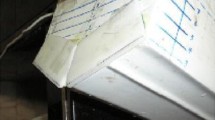Abstract
This paper studied experimental and numerical analyses and design of CFRP rudder with different aspect ratios for 33 feet catamaran racing yacht. To design the effective aspect ratio of rudder, hydrodynamic forces were measured with driving model ships in water channel. Hydrodynamic forces were calculated by the prediction method suggested in International Towing Tank Conference 1978. Finite element method was also applied to examine the structural strength of rudder. Finally, the proper aspect ratio of CFRP rudder was verified through experiments and simulations to satisfy the performance required in racing yacht.
Similar content being viewed by others
References
L. Larsson and R. E. Eliasson, Principles of yacht, McGraw-Hill, USA (2007).
H. S. Seo, H. Y. Jang, I. W. Lee and H. S. Choi, Development of 33feet class America’s cup training CFRP sailing yacht for marine and leisure applications, Journal of the Korean Society for Composite Materials, 28 (1) (2015) 15–21.
L. F. Whicker and L. F. Fehlner, Free-stream characteristics of a family of low-aspect-ratio, all-movable control surfaces for application to ship design, DTMB Report, R933 (1953).
J. R. Patton, Evaluation of dynamic lift coefficients of high aspect ratio rudders and control surfaces, USNA Trident Scholar Project Report, 325 (2004).
E. C. Maskell, Flow separation in three-dimensions, RAE Report, Aero 2565 (1955).
K. C. Wang, Separation patterns of boundary layer over an inclined body of revolution, AIAA Journal, 10 (8) (1972) 1044–1050.
K. S. Min and K. N. Chung, Experimental study for the optimum rudder design, Journal of the Society of Naval Architects of Korea, 37 (2) (2000) 88–99.
K. T. Boo, Y. H. Ji, Y. S. Kim and S. C. Shin, A numerical study of hydrodynamic forces acting on rudders, Journal of the Society of Naval Architects of Korea, 41 (2) (2004) 61–69.
E. J. Barbero, Introduction to composite materials design, CRC Press, Florida, USA (2011).
K. H. Im, J. K. Sim and I. Y. Yang, Impact damages and residual bending strength of CFRP composite laminates subjected to impact loading, Journal of Mechanical Science and Technology, 10 (4) (1996) 423–434.
I. K. Kim, H. G. Kang and K. Onohara, Ultimate strength of composite laminates with free-edge delamination, Journal of Mechanical Science and Technology, 13 (7) (1999) 569–574.
H. S. Seo, H. Y. Jang and I. Lee, Experimental investigation of salt fog effect on the CFRP laminates, Advanced Composite Materials (2016) Doi: 10.1080/09243046.2016. 1187822.
WinDesign VPP, WOLFSON UNIT MTIA, www.wumtia.soton.ac.uk.
C. H. Park, H. Y. Jang, J. W. Jeong, B. S. Lee and H. H. Chun, A study on the ship resistance and moment prediction for running attitude of 30 feet catamaran sailing yacht, Journal of the Society of Naval Architects of Korea, 47 (3) (2010) 321–327.
H. S. Ahn and J. H. Yoo, Hull form development of sailing yacht with sails and appendages, Journal of the Korean Society of Marine Engineering, 30 (1) (2010) 109–115.
MSC Nastran/Patran, Software Package, Ver. 2005, MSC Software Inc. (2005).
Mechanical properties of carbon fiber composite materials, Performance Composites Ltd, www.performance-composites.com.
Divinycell® H 80 sandwich core material, DIAB Inc., www.matweb.com.
A. Michos, G. Bergeles and N. Athanassiadis, Aerodynamic characteristics of NACA 0012 airfoil in relation to wind generators, Wind Eng., 7 (1983) 247–262.
R. E. Sheldahl and P. C. Klimas, Aerodynamic characteristics of seven symmetrical airfoil sections through 180-degree angle of attack for use in aerodynamic analysis of vertical axis wind turbines, Sandia National Laboratories Report, SAND 80-2114 (1981).
K. C. San and Y. F. Fei, Characteristic flow patterns and aerodynamic performance on a forward-swept wing, Journal of Mechanical Science and Technology, 26 (10) (2012) 3103–3110.
Author information
Authors and Affiliations
Corresponding author
Additional information
Hoyun Jang is a Senior Researcher of the Research Institute of Medium & Small Shipbuilding, Busan in Korea. He received his Master of Science Degree from Pusan National University in 2009. His research fields include ship design and experimental fluid dynamics for naval architecture and ocean engineering.
Hyoungseock Seo is a Senior Researcher of the Research Institute of Medium & Small Shipbuilding, Busan in Korea. He received his Dr. Eng. Degree from University of California at Los Angeles in 2008. He is also Korean Register Mac-Net WG-Composite Group Director. His research field is to investigate composite structure design and FEM analysis.
Rights and permissions
About this article
Cite this article
Jang, H., Lee, I. & Seo, H. Effectiveness of CFRP rudder aspect ratio for scale model catamaran racing yacht test. J Mech Sci Technol 31, 4109–4117 (2017). https://doi.org/10.1007/s12206-017-0807-8
Received:
Revised:
Accepted:
Published:
Issue Date:
DOI: https://doi.org/10.1007/s12206-017-0807-8




